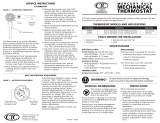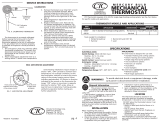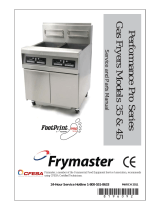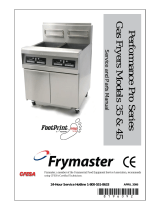Page is loading ...

1 69-0574—2
Heating or Cooling Thermostat
and Wallplate or
Heating/Cooling Thermostat and
Subbase
T8090A/191108A, Q682B
OWNER’S MANUAL
69-0574-2

69-0574—2 2
Welcome to the world of energy savings with your new Honeywell fuel saver thermostat. The
Honeywell name is your assurance of accurate control and reliable operation for years to come.
Your new thermostat will automatically lower and raise the temperature in your home one or
more times every 24 hours. This allows you to significantly lower your fuel costs, while awakening
(or returning home) to a comfortable temperature.
Read this manual to learn how to use your new thermostat.
Recycling Notice
This control contains mercury in a sealed tube. Do not place control in the trash at the end of
its useful life.
If this control is replacing a control that contains mercury in a sealed tube, do not place your
old control in the trash.
Contact your local waste management authority for instructions regarding recycling and the
proper disposal of this control, or of an old control containing mercury in a sealed tube.
If you have questions, call Honeywell Inc. at 1-800-468-1502.
M3375

3 69-0574—2
TABLE OF CONTENTS
Features Of Your Thermostat ........................................................................................................... 4
Setting The Temperature .................................................................................................................. 7
Inserting Clock Batteries ................................................................................................................... 8
Setting The Clock .............................................................................................................................. 9
Programming................................................................................................................................... 10
Troubleshooting .............................................................................................................................. 14
Servicing The Thermostat ............................................................................................................... 23
Cycle Rate Adjustment.................................................................................................................... 23
Thermometer Adjustment................................................................................................................ 24
Warranty.......................................................................................................................................... 27

69-0574—2 4
Features Of Your Thermostat
8 TEMPERATURE SETTING LEVERS. Left
(blue mark) controls the low temperature,
right (red mark) controls the high
temperature.
1 FLIP-UP COVER. Lift it up to set clock for
energy savings and normal temperature
periods.
2 THERMOSTAT COVER. Lift up and
remove to adjust heat anticipator.
3 THERMOMETER. Provides accurate room
temperature reading.
4 CLOCK. This clock provides a 24-hour
slotted dial to hold the programming pins.
5 CLOCK HANDS. Turn minute hand clock-
wise
to match the correct AM or PM
time to the time indicator.
6 TIME INDICATOR. Arrow head indicates
time for 24-hour dial.
7 PROGRAM INDEX WHEEL. Controls high
and low temperature at specific time of day
as set by program pins.
2
1
3
M8726

5 69-0574—2
9 PROGRAM PINS. Must be inserted into
24-hour clock dial slots to control program
index wheel.
10 PIN SLOTS. Located on 24-hour dial at
10-minute intervals for program pin
insertion.
11 MANUAL PROGRAM ADVANCE BUTTON.
Allows change from comfort to energy
savings setting and vice versa without
changing the program.
12 HEAT ANTICIPATOR SCALEPLATE.
Calibrated to match the heating system
current draw in amperes.
13 ANTICIPATOR SETTING LEVER. Must be
adjusted to match the heating system
primary control current.
14 MERCURY BULB AND BIMETAL
ELEMENT (2). Provide automatic tempera-
ture control by switching the heating or
cooling system on or off.
5
8
9
7
6
11
12
13
10
14
M8691
4

69-0574—2 6
15 191108AJ WALLPLATE. Provides mount-
ing base and wiring connections for
heating-only or cooling-only thermostat.
16 Q682B SUBBASE. Provides mounting
base, wiring connections and manual
switching control for heating/cooling
thermostat.
M2421
15
AUTO OFF
COOL
HEATON
FAN
B
O
W
Y
R
G
M719
16

7 69-0574—2
Setting The Temperature
For Heating:
Set the left lever (blue mark) to the energy
savings temperature you want when you are
sleeping or your home is unoccupied.
Set the right lever (red mark) to the tem-
perature you want for normal comfort periods.
NOTE: You may override the time program by
setting both the red and blue levers to the
same temperature set point.
For Cooling:
Set the left lever (blue mark) to the tempera-
ture you want for normal comfort periods.
Set the right lever (red mark) to the energy
savings temperature you want when you are
sleeping or your home is unoccupied.
Fig. 1—Setting high and low
temperature levers.
8
9
10
12
11
1
2
3
4
5
6
7
8
9
10
12
11
1
2
3
4
5
6
7
50
60
70
80
12
6
3
9
50
60 70 80
HIGH
TEMPERATURE
SETTING
LEVER
(RED MARK)
LOW TEMPERATURE
SETTING LEVER
(BLUE MARK)
M1520

69-0574—2 8
Inserting Clock Batteries
Power is supplied to the clock by the 24 Vac
transformer, by two AAA alkaline batteries
(included), or by the heating or cooling control
circuit. Backup batteries may be installed to
supply power to the clock if power is inter-
rupted when using 24 Vac powering method.
Install batteries in thermostat as shown in
Fig. 2. Once a year or when batteries are dead,
replace with two new AAA alkaline batteries.
We recommend Energizer
®
batteries.
Fig. 2—Inserting clock batteries.
BATTERY LOCATION FOR
(2) AAA BATTERIES;
INSTALL WITH POSITIVE
ENDS UP
M7188

9 69-0574—2
Setting The Clock
Lift thermostat flip-up cover and you’ll find
the 24-hour program dial, slotted in 10-minute
increments. Adjust the clock to the current time
by moving the minute hand carefully in clock-
wise direction. DO NOT reverse the
minute hand.
When time is correctly set, the Time
Indicator Arrow (see Fig. 3) will point to the
correct time and corresponding daytime (light)
or nighttime (dark) band of the program dial.
EXAMPLE: For 11 PM, the time indicator arrow
will point directly to dark band. For 11 AM,
the arrow will point to light band on dial.
Daylight Savings Time
When Daylight Savings Time starts, move
the minute hand carefully in a clockwise
direction one hour. When Daylight Savings
Time ends, move the minute hand carefully in
a clockwise direction 23 hours. Do NOT
reverse the minute hand, or damage to timer
mechanism may occur.
Fig. 3—Setting the clock.
TIME
INDICATOR
ARROW
MINUTE
HAND
M8561

69-0574—2 10
Programming
You can program your thermostat to
automatically lower and raise the temperature
one or more times every 24 hours.
Before setting your program:
Lift thermostat flip-up cover and you'll find
the 24-hour program dial. The slots on the
program dial (Fig. 4) are for the program pins
that can be inserted at ten-minute intervals.
Three red and three blue program pins are
included with your thermostat. The red pins
start the high-temperature period; the blue pins
start the low-temperature period. A heating
program has been preprogrammed. A red pin
is inserted at 6:00 AM for high temperature
(comfort period); a blue pin is inserted at
10:00 PM for low temperature (energy saving
period). Two additional sets of pins are located
in the program pin storage area. You can set
up to six temperature changes with the pins
supplied. We recommend at least five hours
for each energy saving period.
Fig. 4—Program components.
24-HOUR PROGRAM DIAL
(GRAY AREA FOR
NIGHT SETTINGS)
FLIP-UP
COVER
PROGRAM
PINS
THERMOSTAT
COVER
PROGRAM PIN SLOT
PROGRAM INDEX WHEEL
PROGRAM PIN
STORAGE
TIME INDICATOR
ARROW
MANUAL PROGRAM
ADVANCE BUTTON
M8692

11 69-0574—2
To change the pins or add a new
energy savings period:
• To insert a pin, push it straight into the
selected notch on the program dial until it’s
completely seated.
• To remove a pin, press against program dial
and pull the pin straight out. DO NOT attempt
to change a pin if it is engaged with the
program index wheel.
• On heating/cooling systems, you must reset the
pins when the seasons change. You will also
probably want to change the lever positions.
Setting the Heating Program:
Decide when you want the temperature to
reach the comfort level. Find the notch on the
dial that’s one-half hour before this time and
insert a
red
pin. The half-hour head start gives
the furnace time to heat the house before you
wake up or arrive home.
Decide when you want the energy savings
period to start and insert a
blue
pin at the notch
that corresponds to this time. After the blue pin
engages, the furnace will be off until room temp-
erature drops to the energy savings set point.
Fig. 5—Programming examples.
• You can set both a day and a night pro-
gram. See Fig. 5 for program examples.
WINTER SUMMER
TEMPERATURE
PROGRAM
PIN IN
CONTROL
NIGHT
ENERGY
SAVING
PERIOD
DAY
ENERGY
SAVING
PERIOD
BEGINS
10:00 PM
ENDS
6:00 AM
BEGINS
7:30 AM
ENDS
4:00 PM
TEMPERATURE
PROGRAM
PIN IN
CONTROL
°C
27
24
27
24
RED
BLUE
RED
BLUE
°F
58
68
58
68
°C
14
20
14
20
°F
80
75
80
75
BLUE
RED
BLUE
RED
M1690B

69-0574—2 12
Setting the Cooling Program:
Decide when you want the temperature to
reach the comfort level. Find the notch on the
dial that’s one-half hour before this time and
insert a
blue
pin. The half-hour head start gives
the air conditioner time to cool the house
before you wake up or arrive home.
Decide when you want the energy savings
period to start and insert a
red
pin at the notch
that corresponds to this time. After the red pin
engages, the air conditioner will be off until
room temperature rises to the energy savings
set point.

13 69-0574—2
Start Or End Programs With Manual Program
Advance Button
IMPORTANT:
To prevent damage to the program
advance mechanism, DO NOT use the
program advance button within a 30-minute
period before or after a program change.
The manual program advance button
enables immediate, one-time-only program
changes to accommodate temporary schedule
changes.
Press the button to immediately begin an
energy savings period or return to the normal
setting. After pressing the button, check the
program indicator to ensure the system is in
the desired mode. If the program indicator
shows blue, the lower temperature is in effect;
if it shows red, the higher temperature is in
effect. Using the manual advance button will
not affect the stored program.

69-0574—2 14
Troubleshooting
Your Honeywell thermostat requires little or no attention. Most problems can generally be
traced to the following:
Problem Check Action
No heat. — system switch. May be in OFF or
COOL position.
Move system switch to HEAT position.
— fuse or circuit breaker. If blown or tripped, replace fuse or reset
breaker.
— furnace power switch. May be Off. Move switch to ON.
— pilot flame. May be out. Relight pilot flame per furnace manufacturers
instructions.
—R and W thermostat connections. Turn Off power to furnace. Check for correct
terminal hookups. Repair any frayed or
broken wires. Firmly tighten all terminal
screws. Turn On power.
— other problem. Contact a qualified service technician for
assistance.
1
(continued)

15 69-0574—2
Troubleshooting
(continued)
Problem Check Action
Energy savings
temperature program
12 hours off.
— program dial for proper day or
night phase.
Turn timer ahead 12 hours. Move setting
knob clockwise only.
Rooms do not warm
up at programmed
time.
— timer program for heating system.
May need more time to warm up
rooms.
Move red pin one-half hour earlier on the
program dial.
Temperature change
occurs at the wrong
time.
— programs pins for correct time
locations.
Relocate pins to desired settings.
Room temperatures
are not correct.
— positions of thermostat setpoint
levers.
Reset to desired temperatures.
— position of subbase system
switch.
Move to desired operating position.
(continued)
2

69-0574—2 16
Troubleshooting
(continued)
(continued)
Problem Check Action
Room temperatures
are not correct
(continued).
— thermostat circuits. HEATING-ONLY SYSTEM—Move
temperature setting levers 5°F (3°C)
above room temperature. Heating system
should start. If the system does not
operate, call a qualified technician.
COOLING ONLY SYSTEM–Move
temperature setting levers 5°F (3°C)
below room temperature. Cooling system
should start. If the system does not
operate, call a qualified technician.
HEATING/COOLING SYSTEM—With
system switch at HEAT, move
temperature setting levers 5°F (3°C)
above room temperature. Heating
system should start.

17 69-0574—2
Troubleshooting
(continued)
Problem Check Action
Room Temperatures
are not correct
(continued).
With system switch at COOL, move
temperature setting levers 5°F (3°C) below
room temperature. Cooling system should
start. If the systems do not operate, call a
qualified technician.
Burner-on time too
short.
— anticipator setting. (See figure on
page 23 for anticipator location.)
Increase anticipator setting by 0.05.
Observe burner operation.
Burner-on time too
long.
— anticipator setting. (See figure on
page 23 for anticipator location.)
Decrease anticipator setting by 0.05.
Observe burner operation.
No cooling. 1
— system switch. May be in OFF or
HEAT position.
Move switch to COOL position.
— fuse or circuit breaker. If fuse is blown or breaker tripped, replace or
reset.
(continued)

69-0574—2 18
Troubleshooting
(continued)
Problem Check Action
No cooling 1
(continued)
— condenser switch position.
Located outdoors and may be
turned OFF.
Move to ON position.
— thermostat connections. Check
for correct terminal hookups.
Repair any frayed or broken wires.
Firmly tighten all terminal screws.
Turn OFF power to cooling system.
— other. Contact a qualified service technician for
assistance.
Thermostat setting
and thermometer
— level position of thermostat. Reinstall thermostat wallplate or subbase.
Use a spirit level.
reading disagree.
— area around thermostat for drafts
or radiant heat.
Thermostat should be about 5 ft (1.5m)
above floor on an inside wall. Contact
qualified service technician for change of
location.
(continued)

19 69-0574—2
Troubleshooting
(continued)
3
Problem Check Action
Thermostat setting
and thermometer
reading disagree
(continued).
— calibration of thermometer. See instructions on page 24.
Clock does not run. — thermostat connections at
the two C terminals. If no
connections, clock needs
batteries in order to run.
Batteries may not have been
installed.
Batteries may need replacement
Install as shown on page 8.
Replace with two new AAA alkaline batteries
as shown on page 8.
— if new batteries are installed and
clock still does not run.
Replace thermostat.
— voltage across the two C
terminals.
Remove thermostat from the wallplate or
subbase and measure the voltage. Refer to
the table on page 22 for cause and reaction.
(continued)

69-0574—2 20
Troubleshooting
(continued)
(continued)
Problem Check Action
Clock does not run
(continued).
— pins in program dial. If pins are
not completely seated in program
dial, jamming with index wheel
may occur.
Push down on pins to make sure they are
completely seated in program dial.
Clock loses time. — power. May be interrupted. Make sure power is on. Reset clock.
— high limit control. If clock powered
through system transformer,
power to clock and equipment
may be off on safety.
Wire separate transformer to power clock, or
install backup batteries as shown on page 8.
— filter. May be clogged. Safety
limit on equipment may cut off
power to system.
Replace filter and reset clock.
/



